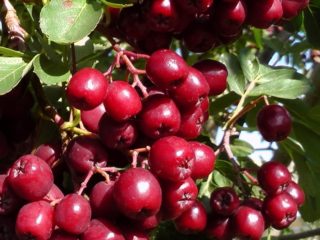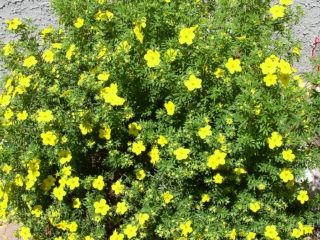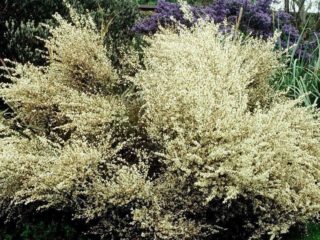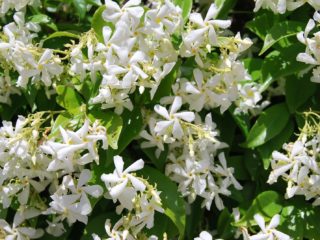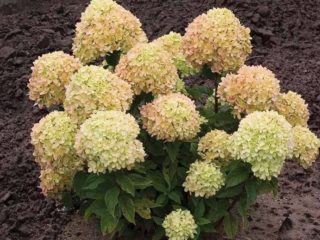Content
The stephanandra Crispa shrub is becoming increasingly popular in landscape and park design. The homeland of this exotic ornamental plant is Southeast Asia. In their natural environment, beautiful bushes grow on mountain slopes and the outskirts of forests. When comfortable conditions are provided, culture develops well in many Russian regions.

The width of the lush crown of Stephanander Crisp is much greater than its height
Description and photo of Stefanandra Crispa
Stephanandra incisa Crispa (Stephanandra incisa Crispa) is a plant belonging to the botanical family Rosaceae. A shrub with catchy openwork foliage and abundant flowering stands out against the background of other ornamental crops. In terms of the structure of flowers, Stephanandra Crispa is similar to its relatives in the Rosaceae family - cherry, pear, plum, etc., but the plant does not produce fruit. White and cream buds bloom on the bushes in late May or early June. Loose inflorescences exude a pleasant aroma.
Thin shoots of the stephanandra shrub variety Crispa are red-brown in color.The leaves, alternately located on the branches, look like wide lobes at the base with teeth along the edges, and sharply taper towards the end. A peculiarity of the plant is the strong dissection of the plates, due to which the dense crown of the bush appears openwork. By autumn, the foliage changes color from green to red-orange or scarlet-brown.
Advantages and disadvantages
Stefanandra variety Crispa is an exotic plant with emphatically decorative qualities and is a spectacular element of a garden plot or park area.

The flowering period of the stephanandra shrub variety Crispa lasts approximately 30 days.
Pros:
- disease resistance;
- adaptability to wintering at low temperatures;
- ease of crop care.
Minuses:
- poor adaptability to persistently dry weather;
- when the crown becomes very thick, the plant sheds its leaves.
Planting Stephanandra Crispa
The lush, low-growing shrub is adapted to the conditions of the middle zone, but the plant can also be cultivated in more northern latitudes. When starting to plant an ornamental crop, it is important to choose the right location. For the full development of stephanandra Crispa bushes, choose a site that meets a number of requirements. It should be an open, sunny place with loose soil. The most suitable types of soil:
- loamy;
- sandy loam;
- black soil;
- peat-sandy.
Dense soil is dug up and thoroughly loosened before planting. Heavy soil is an obstacle to the adaptation of the bush in the garden. If necessary, the soil is fertilized with humus or mature compost is added to it.Planting work consists of a number of sequential operations.
- Dig a hole, the dimensions of which correspond to the size of the root system.
- Create drainage from small stones, broken bricks, and gravel.
- A sand layer 10 cm thick is formed.
- Place the seedling in the center of the planting hole. Fill the holes with soil and gradually compact it. Water the bush from a garden watering can.
After planting, it is advisable to mulch the root zone with dry leaves, grass, and sawdust. Natural shelter retains moisture in the soil and prevents the growth of weeds.
Caring for Stephanandra Crispa
The stephanandra Crispa plant is quite unpretentious, but to maintain a healthy, aesthetic appearance, the bushes require careful care. Agricultural technology includes:
- frequent watering with settled water in the absence of precipitation, at least three times a week;
- fertilizing with nitrogen-containing fertilizers and organic matter - infusion of chicken manure or dry humus;
- regular weeding combined with loosening the soil;
- formative pruning for active growth of shoots and giving the bush a presentable appearance.
In order to protect the stephanandra bush from freezing when the temperature threatens to drop to -25 0Shelter is being prepared for the winter. To do this, the shoots are bent to the ground, covered with spruce branches and leaves. A fairly thick layer of soil is created on top. In spring, the shelter is removed and the bushes are tidied up. In addition to the formative removal of branches, sanitary treatment of the crown is organized annually in the spring. The procedure involves pruning spoiled and frozen shoots.

To make the bushes more decorative, they are carefully thinned out and the outer shoots are shortened.
Diseases and pests
Stefanandra is resistant to common diseases that affect other shrub crops. However, agricultural technicians recommend annual preventive treatment of plantings with Bordeaux mixture or fungicides. Insects do not harm ornamental plantings.
Photo of Stefanandra Crispa in landscape design
Crispa bushes look spectacular in spring, summer and autumn. Low specimens look advantageous against the background of dark green conifers: juniper, spruce, fir. Another option for using decorative crops in landscape design is to design the shore of a small reservoir.

Stephanandra plantings highlight the long paths in the large garden and park alleys.
As a result of many years of work, breeders developed a dwarf form of stephanandra. With a bush diameter of 2 m, the height of the plant does not exceed 60 cm. Dwarf species can be used when decorating an alpine hill in combination with ground cover plants. Advanced gardeners successfully combine low-growing bushes with such ornamental crops as spirea, bladderwort, deutzia and ram.

Dwarf stephanandra - a spectacular element of a spacious garden plot
Conclusion
Stefanandra Crispa retains its high decorative qualities throughout the warm season, making it a sought-after landscaping element for both garden plots and urban areas. The spectacular plant attracts everyone's attention with its beautiful shape of carved leaves, lush crown and abundant flowering.
Reviews of Stefanandra Crispa





